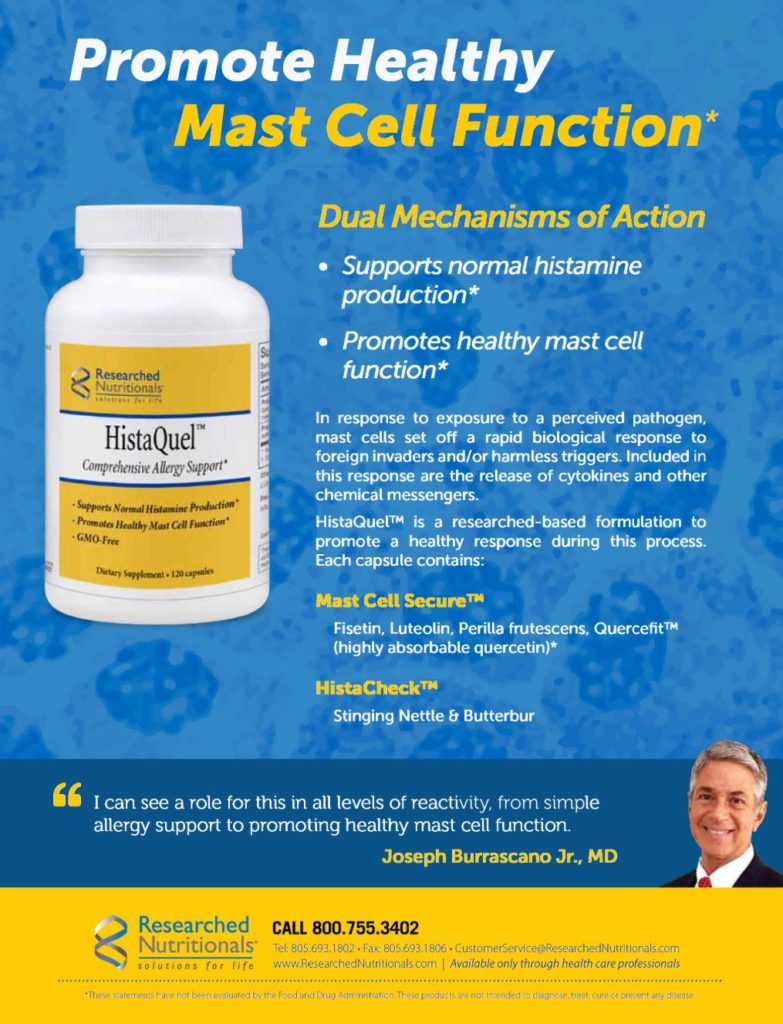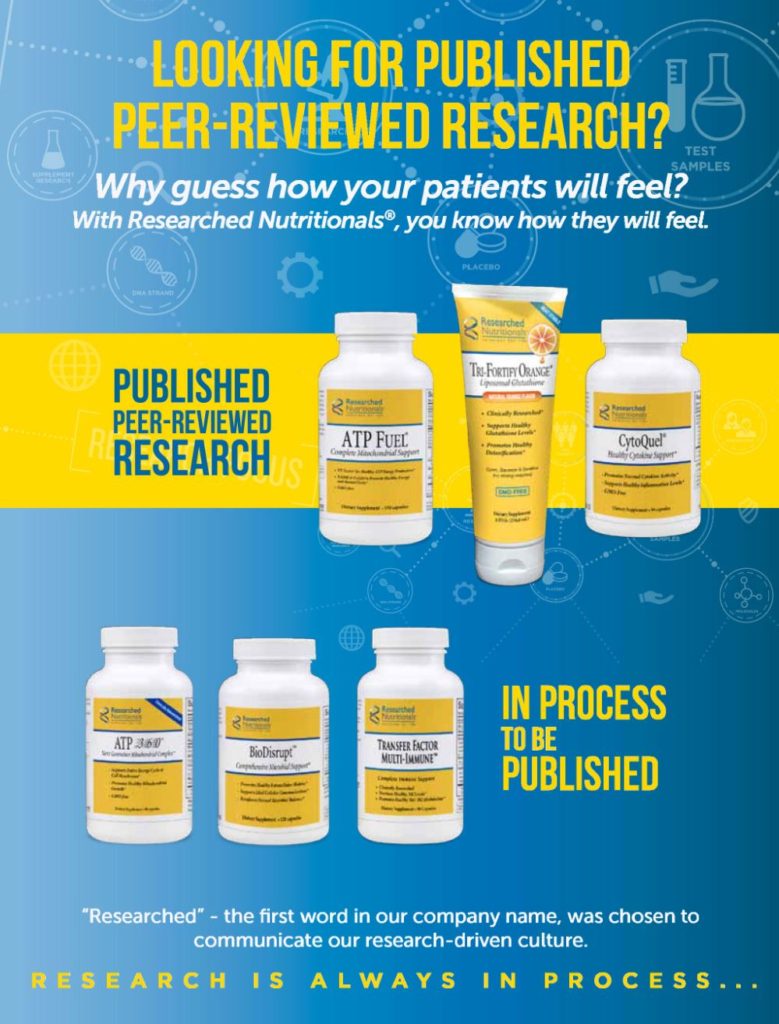#433/434

By Alan R. Gaby, MD
Vitamin D for Lung Cancer
One hundred fifty-five Japanese patients (mean age, 68 years) with non-small cell lung cancer were randomly assigned to receive, in double-blind fashion, 1,200 IU per day of vitamin D or placebo, beginning after surgery and continuing for one year. During a median follow-up period of 3.3 years, the relapse rate was 28% and the death rate was 17%. There was no significant difference between groups in relapse-free survival or overall survival time. However, in the pre-specified subgroup analysis of patients with early-stage adenocarcinoma and a serum 25-hydroxyvitamin D level less than 20 ng/ml, the vitamin D group had significantly better five-year relapse-free survival (86% vs. 50%; p = 0.04) and overall survival (91% vs. 48%; p = 0.02), compared with the placebo group.
Comment: This study showed that vitamin D supplementation may increase survival times and increase the time until a relapse occurs in patients with early-stage adenocarcinoma of the lung and a low serum 25-hydroxyvitamin D level. However, vitamin D was not beneficial in patients with higher 25-hydroxyvitamin D levels, later-stage lung cancer, or lung cancer other than adenocarcinoma. If correcting vitamin D deficiency is beneficial for a subset of patients with lung cancer, the mechanism may involve an improvement in immune function.
Akiba T, et al. Vitamin D supplementation and survival of patients with non-small cell lung cancer: a randomized, double-blind, placebo-controlled trial. Clin Cancer Res. 2018;24:4089-4097.
More on Vitamin D and Cancer
One hundred thirty-nine patients (mean age, 56 years) with advanced or metastatic colorectal cancer were randomly assigned to receive, in double-blind fashion, high-dose or low-dose vitamin D in addition to chemotherapy. High-dose vitamin D was 8,000 IU per day for the first chemotherapy cycle, followed by 4,000 IU per day. Low-dose vitamin D was 400 IU per day. At baseline, the median 25-hydroxyvitamin D level was 16.1 ng/ml in the high-dose group and 18.7 ng/ml in the low-dose group. During a median follow-up period of 23 months, the median progression-free survival time was 13 months in the high-dose group and 11 months in the low-dose group (p = 0.07). When expressed as a hazard ratio, the multivariable-adjusted hazard ratio for progression-free survival was 0.64 (p = 0.02), which suggested a beneficial effect of vitamin D.
In a second study published in the same issue of the same journal, 417 Japanese patients with digestive tract cancers (48% colorectal, 42% gastric, 10% esophageal) were randomly assigned to receive, in double-blind fashion, 2,000 IU per day of vitamin D or placebo, beginning at the first postoperative outpatient visit. At baseline, 42% of the patients had a 25-hydroxyvitamin D level below 20 ng/ml. During a median follow-up period of 3.5 years, the death rate was 15% in each group. Five-year relapse-free survival was nonsignificantly higher with vitamin D than with placebo (77% vs. 69%). There was no evidence that vitamin D was more effective in patients with baseline 25-hydroxyvitamin D levels below 20 ng/ml than in other patients.
Comment: The results of these studies, when combined with the study cited above, are consistent with a modest benefit of vitamin D supplementation in certain subsets of patients with cancer. Further research is needed to determine which types of cancer patients are most likely to benefit from vitamin D and what the optimal dosage range is.
Ng K, et al. Effect of high-dose vs standard-dose vitamin D3 supplementation on progression-free survival among patients with advanced or metastatic colorectal cancer: the SUNSHINE randomized clinical trial. JAMA. 2019;321:1370-1379.
Urashima M, et al. Effect of vitamin D supplementation on relapse-free survival among patients with digestive tract cancers: the AMATERASU randomized clinical trial. JAMA. 2019;321:1361-1369.
Unmetabolized Folic Acid and Cancer Risk
In a previous randomized controlled trial of folic acid supplementation in patients with a history of colorectal adenomas, there were indications that folic acid increased the risk of adenoma recurrences during later years.1 In a post hoc analysis of the original study, researchers measured serum levels of methylated folates (the sum of 5-methyltetrahydrofolate and 4-alpha-hydroxy-5-methyltetrahydrofolate) and unmetabolized folic acid in 924 participants at baseline and after three years of supplementation. No association was found between plasma methylated folates or unmetabolized folic acid (measured at 3 years) and risk of adenoma recurrences. However, during later follow-up (up to 8 years of supplementation), the pre-specified endpoint of high-risk findings (multiple or advanced adenomas) was positively associated with plasma methylated folates (p for trend < 0.01), with a 58% increased risk for participants in the highest vs. the lowest quartile. There was an inverse association between plasma unmetabolized folic acid and high-risk findings (p for trend < 0.05) and between plasma unmetabolized folic acid and advanced adenomas (p for trend = 0.07). A significant inverse association was also seen between methylated folates and risk of serrated adenomas, with a 39% lower risk in the upper versus the lower quartile (p for trend = 0.03).
Comment: There is conflicting evidence regarding whether folic acid supplementation affects cancer risk. Various studies have suggested increased risk, decreased risk, and no effect. Some researchers and practitioners have suggested that, if folic acid does increase cancer risk, the effect might be due to unmetabolized folic acid. If that is the case, then 5-methyltetrahydrofolate (also called 5-MTHF or methylfolate) might be preferable to folic acid for use as a nutritional supplement. I have previously challenged the argument that 5-MTHF is generally a more effective supplement than folic acid, and I have cited evidence that in some cases 5-MTHF may be less effective than folic acid (including in patients with the 677C→T polymorphism of methylenetetrahydrofolate reductase).2
In the present study, higher serum concentrations of unmetabolized folic acid were associated with a lower incidence of high-risk precancerous adenomas. That finding does not support the idea that unmetabolized folic acid increases cancer risk. The findings with regard to 5-MTHF were less clear, with both adverse and protective effects observed, depending on the outcome being measured. The results of the present study do not suggest that unmetabolized folic acid is preferable to 5-MTHF with respect to cancer risk.
Rees JR, et al. Unmetabolized folic acid, tetrahydrofolate, and colorectal adenoma risk. Cancer Prev Res. 2017;10:451-458.
Organic Foods and Cancer Risk
Some 68,946 French adult volunteers (mean age, 44 years) completed a questionnaire regarding the frequency with which they consumed the organic version of 16 food items (never, occasionally, or most of the time). From these data, an organic food score was calculated. During a mean follow-up period of 4.6 years, 1,340 first cases of cancer were documented, the most prevalent being 459 breast cancers, 180 prostate cancers, 135 skin cancers, 99 colorectal cancers, 47 non-Hodgkin lymphomas, and 15 other lymphomas. After adjustment for potential confounding variables (including age, sex, occupation, education level, marital status, income, physical activity, smoking status, alcohol intake, family history of cancer, body mass index, energy intake, fiber intake, and processed meat intake), high organic food scores were inversely associated with the overall risk of cancer (hazard ratio for the highest vs. the lowest quartile = 0.75; p for trend = 0.001). The absolute risk reduction for the highest vs. the lowest quartile was 0.6%, indicating six fewer cases of cancer per 1,000 individuals during the study period.
Comment: In this study, more frequent consumption of organic foods was associated with a lower risk of developing cancer. Numerous other observational studies have reported similar findings, and animal studies indicate that some pesticides are carcinogenic. Although randomized controlled trials would be needed to prove that eating organic foods prevents cancer, avoiding pesticides as much as possible seems like a prudent thing to do.
Baudry J, et al. Association of frequency of organic food consumption with cancer risk: findings from the NutriNet-Sante Prospective Cohort Study. JAMA Intern Med. 2018;178:1597-1606.
Cow’s Milk, Estrogen, and Cancer
One hundred nine postmenopausal women consumed 1 liter per day of semi-skimmed milk (1.5% fat) for four days and 1 liter per day of whole milk (3.5% fat) for four days, with a four-day washout period between the interventions. Sex steroid hormone concentrations were measured in 24-hour urine samples at baseline and at the end of each intervention. Compared with baseline, mean urinary excretion of estrone increased significantly with both types of milk; the increase was somewhat greater with semi-skimmed than with whole milk. Urinary excretion of estradiol and estriol increased after consumption of semi-skimmed milk but not after consumption of whole milk.
Comment: In order to maximize milk production, milk cows are kept pregnant most of the time, with only short intervals between pregnancies. However, the milk of pregnant cows contains higher levels of pregnancy hormones, compared with the milk of non-pregnant cows. The increase in estrone concentrations after consumption of cow’s milk might explain the reported association between cow’s milk consumption and several hormone-sensitive cancers (including breast, uterine, and prostate cancer).
Michels KB, et al. Urinary excretion of sex steroid hormone metabolites after consumption of cow milk: a randomized crossover intervention trial. Am J Clin Nutr. 2019;109:402-410.
Choline Decreases Some of the Adverse Effects of Alcohol Consumption During Pregnancy
Sixty-nine pregnant women in Cape Town, South Africa, who had been heavy alcohol consumers during at least part of their pregnancy were randomly assigned to receive, in double-blind fashion, 1 g of choline twice a day or placebo, beginning at a mean of 20 weeks of gestation and continuing until delivery. After exclusion of four children whose mothers took less than 20% of the study medication, the proportion of children who passed the eye blink conditioning test (an indicator of neurological development) at age 6.5 months was significantly higher in the choline group than in the placebo group (66.7% vs. 34.6%; p < 0.04). While both groups were small at birth, the choline group (but not the placebo group) showed considerable catch-up growth in weight and head circumference at 6.5 and 12 months of age. At 12 months of age, the choline group had better visual recognition memory than the placebo group.
Comment: Choline plays a key role in the development of the fetal brain, whereas prenatal alcohol exposure impairs fetal brain development. The results of the present study indicate that choline supplementation during pregnancy can decrease some of the adverse effects of maternal alcohol consumption on the child’s neurological development, postnatal growth, and cognition. Pregnant women should be strongly discouraged from drinking alcohol, but in women who do not comply with that recommendation, choline supplementation may provide some benefit.
Jacobson SW, et al. Efficacy of maternal choline supplementation during pregnancy in mitigating adverse effects of prenatal alcohol exposure on growth and cognitive function: a randomized, double-blind, placebo-controlled clinical trial. Alcohol Clin Exp Res. 2018;42:1327-1341.
Does Eating Sugar Impair Fertility?
The association between sugar-sweetened beverage consumption and fertility was examined in a prospective cohort study of 3,828 North American women (aged 21-45 years) who had been attempting to become pregnant for six months or less and 1,045 of their male partners. Participants completed a baseline questionnaire that assessed sugar-sweetened beverage consumption during the previous four weeks, and they were followed until pregnancy or for up to 12 menstrual cycles. As compared with no intake of sugar-sweetened beverages, consumption of seven or more servings per week was associated with a significant 20% decrease in both males and females in the fecundability ratio (defined as the probability of conception in any given cycle).
Comment: In a previous study, consumption of a diet high in sucrose (2.6 g per kg of body weight 2 days a week) inhibited oocyte maturation in monkeys.3 In addition, feeding sugar-sweetened drinks (25% of total calories) resulted in impaired fertility in male mice.4 In a cross-sectional study of college men, higher intake of sugar-sweetened beverages was significantly associated with lower sperm motility.4 The results of the present study suggest that excessive sugar consumption may decrease fertility in humans as well.
Hatch EE, et al. Intake of sugar-sweetened beverages and fecundability in a North American preconception cohort. Epidemiology. 2018;29:369-378.
Probiotic for Chronic Periodontitis
Forty-one Brazilian patients with chronic periodontitis were randomly assigned to receive, in double-blind fashion, lozenges containing Bifidobacterium animalis subsp. lactis HN019 (109 colony-forming units per lozenge) or placebo lozenges twice a day for 30 days. All patients received scaling and root planing at the beginning of the study. At 90 days, the mean decrease in probing pocket depth and the mean clinical attachment gain were significantly greater in the probiotic group than in the placebo group.
Comment: In this study, treatment with lozenges containing Bifidobacterium animalis subsp. lactis HN019, when used as an adjunct to scaling and root planing, were beneficial in the treatment of chronic periodontitis. While the mechanism of action is not known, this probiotic might work by decreasing the number of pathogenic organisms in the mouth.
Invernici MM, et al. Effects of Bifidobacterium probiotic on the treatment of chronic periodontitis: A randomized clinical trial. J Clin Periodontol. 2018;45:1198-1210.
References
- Cole BF, et al. Folic acid for the prevention of colorectal adenomas: a randomized clinical trial. JAMA. 2007;297:2351-2359.
- Gaby AR. Which supplement should we use: folic acid or methylfolate? www.doctorgaby.com/articles
- Chaffin CL, et al. Dietary sugar in healthy female primates perturbs oocyte maturation and in vitro preimplantation embryo development. Endocrinology. 2014;155:2688-2695.
- Chiu YH, et al. Sugar-sweetened beverage intake in relation to semen quality and reproductive hormone levels in young men. Hum Reprod. 2014;29:1575-1584.







